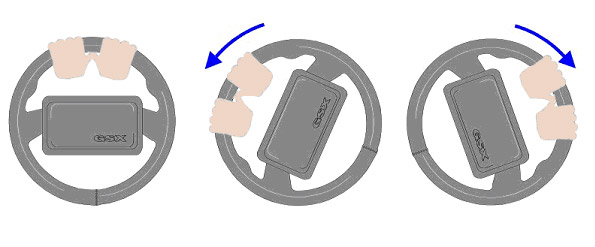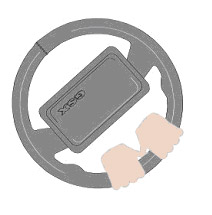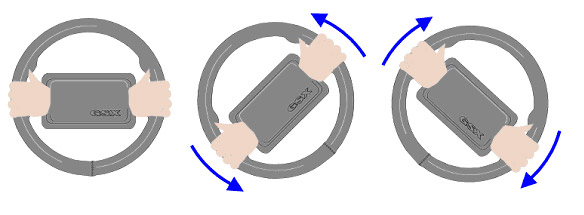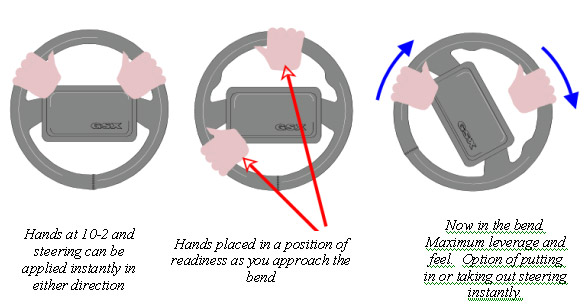Steering Techniques
Julian Smith from Ride Drive gives us some guidance on guidance.
Isn’t it strange how whenever anyone thinks of a learner driver in the process of undertaking a driving lesson the mental image that immediately comes to mind is of the driving school car doing, what we the more senior members of society call a three-point-turn and how part of that image is that of the learner shuffling the steering wheel left and right with a kind of shy awkwardness?
Is it because we associate the ‘feeding’ of the wheel with a learner driver that we almost immediately after passing our driving test re-invent the method of steering? Whatever the reason it seems that nearly every driver drops what is given to be the correct steering method very shortly after passing their test and very soon are crossing their arms, steering one-handed and indeed, since the advent of the mobile telephone, steering with their knees!
Forget 'Cool'
So what is it that makes us think that we can do better? For one thing, and you have to have teenage kids to get into this mindset, it is not seen as ‘cool’ to handle the steering wheel in the orthodox push-pull method. Film stars and television commercials have put pay to that. Brad Pitt or Tom Cruise would never have had any street-cred’ feeding the wheel from hand to hand on the big silver screen, and it is stars of that arena that unfortunately have so much influence over the way in which many think and act. It’s a bit like the school swot, the Hermionne Granger that always completes their homework on time and knows the answer to every question in the history lesson. The rest of the class will sneer and ridicule, even though they themselves may be wrong.
Image wise driving has always had a certain roughy-toughy kind of decadence attached to it, and if we have a slightly rebellious attitude towards what we do on the road it somehow makes us feel proud of ourselves. It is that pride helps us to justify what we do as being something that is harmless. This is where the perceived ability comes in, which as the rest of us know, is considerably higher up the ladder than reality. You see, we all can think we are good drivers whilst we are getting away with our poor ways. “I’ve never had an accident in 15 years!” is a common one, but usually means that the driver has been lucky enough to have got away with it for so long, but will have had countless ‘moments’ along the way.
Don't kid yourself...
Every time you have to brake suddenly, swerve to avoid someone or something, or had to take some form of avoiding action you have been caught out, and you only get caught out when you make a mistake.
The trouble is that when we get away with mistakes for long enough they cease to be mistakes and then become ‘normal’ occurrences. When that happens, and we do have a collision because of the way we drive, we cannot always accept that we are at fault and that we may be lacking somewhere in the driving skills department. It’s a bit like sex really. We can get a real kick out of it in terms of enjoyment, but unless our partner says otherwise we all think we are doing it rather well. What if our partner does tell us that we are doing it wrong…..? Wow, that opens up a right old can of worms doesn’t it? We have to deal with all the hurt and damaged pride and probably, unless several partners tell us the same, we go into self-denial thinking I am right and everyone else is wrong. The same with driving, “How can I possible be wrong? I have always been a safe driver!”
Back to the Wheel
So, how important is the way in which we use a steering wheel?
Almost every road collision is caused through driver error, and getting in a fuddle with the pointing device rates quite highly on that list of what we get wrong.
The steering wheel is the most important item on the list of vehicle controls because it has such a profound effect on the behaviour of that vehicle. True it makes it change direction, but there are a number of side effects it creates also. It can drastically change the balance of the car in terms of where the weight is shifted. In fact it can cause a whole storm of forces that can be all mixed up and thrown in just about every direction, but do many drivers understand that?
Let us take a close look at steering techniques and perhaps we will come to an informed decision as what exactly is the best method.
Balance Matters
Maintenance of the balance and stability of the car is of paramount importance, and even more so as the speed increases into the higher ranges. Any input that is made through the steering wheel has to be done smoothly, progressively and with feeling. You will very soon become unstuck if you just grab a big handful of wheel and yank it round as this will badly destabilise the car. Not much in the way of finesse there!
When a car is travelling straight ahead and you turn the steering wheel either left or right, the momentum within the car still wants to take it straight ahead. The front wheels have now got to fight that straight-ahead force by creating a counter-force of their own through the front tyres, if they are going to cause the car to deviate left or right, and that counter-force to be stronger than the straight-ahead force if it is going to win. If you load up the steering gently and gradually the car will corner far more effectively than if you try and jerk it round. It’s a bit like picking up a heavy box from a table-top. When you progressively apply the power through your muscles to lift it you may manage the task quite well, but if someone were to throw that box into your arms, even if it was from the same height as the table, you would probably drop it. This is because the demands that have been placed upon your physical strength have been too much, too quick for you to cope.
Let’s look at some of the ways in which some people use the steering wheel.
1) The Handlebar method
This is where the driver will place both hands together at the twelve o’clock position on the wheel rim and then, without moving from that same bit of wheel, will swing left or right in response to the direction that the car is required to move in. For a start your body is completely off-balance, which makes it impossible to ‘connect’ with the car, spiritually or otherwise, and difficult to apply steering smoothly and progressively. Also, with your hands cranked all the way around to 5 or 7 o’clock, what are you going to do when you need to put in some more steering? Can’t be done from that position can it?

 Your arms have already moved to the full extent of their travel and the only way in which you are going to put in more steering is to change your hand position, and that takes time – time you may not have. Not good for getting that ultimate degree of control.
Your arms have already moved to the full extent of their travel and the only way in which you are going to put in more steering is to change your hand position, and that takes time – time you may not have. Not good for getting that ultimate degree of control.
2) One handed steering
One hand on the wheel and elbow on the door-top or centre armrest. Again the driver is off-balance within the car and is not in a position to exert maximum leverage on the wheel if called upon to do so. Hardly the position of readiness and, to be quite frank about it, it looks sloppy.
3) No handed, hey but I can use my knees
Doesn’t even deserve discussion.
4) Cross-handed steering
Knitting, as I call it. This is where you turn the wheel hand-over-hand in order to steer the vehicle and probably the method to which you deteriorate to first as your discarded ‘L’ plates fade even further out of your memory.
I will stick my neck out here, and maybe ruffle a few feathers in the purist’s camp, by saying that I could never really see a problem with this one if used when slow-manoeuvring in confined spaces only, such as parallel parking or turning the car around in a confined space.
On the road, however, this again puts the drivers’ body off-balance within the driving seat and does hinder that ability to apply steering smoothly and progressively. I have even seen this used with a reversed hand position, that is to say with the palm of the hand inside the wheel rim with fingers grasping around the back – nails towards the driver. Very awkward and very limited control potential offered.
5) Fixed Arm steering
This actually carries some credibility, but its use is more a specialist one. During pursuit management training, British police traffic patrol officers carry out an exercise where they have to drive through a slalom course of traffic cones as quickly as possible, both in a forward direction and again in reverse. The steering method taught is to grip the wheel at the 3 and 9 o’clock positions on the rim and keep the hands there whilst turning the wheel to the left and right in accordance to the spacing of the cones.
One of the reasons for this is that when you make changes in direction at such a high frequency at speed, as when completing this exercise, the power steering pump can’t actually keep up with the demands being placed upon it.

The consequence of this is that after about three or four direction changes the steering suddenly becomes a dead-weight and requires a considerable degree of physical effort to keep it going. By placing the hands in the position described you remain perfectly balanced in the driving seat, you can input the steering progressively and with sensitivity as well as exerting maximum leverage on the wheel.
Yes, as with the ‘Handlebar’ approach, you can arrive at the situation where you have your hands at the full extent of their travel and therefore unable to apply more steering input readily, but now you are having to deal with another and more immediate situation. It’s a compromise and has no place for normal road use.
Recommended Method
The method we promote at Ride Drive is a kind of cross between the pull-push method and fixed grip steering and it works very well.
The hands grip the wheel rim in the traditional 10-2 position with the thumbs pointing towards one another along the rim in a relaxed manner, but ready to tighten the grip if needed. As you then approach a right-hand bend, for example, the right hand moves to the top of the wheel and the left one moves to the bottom. Now, as the car enters the bend, in fixed grip style progressively apply the steering until you have the amount required to negotiate the corner. If you judge it correctly, and this all ties in now with accurate bend analysis and assessment, you will be cornering with your hands in the 10-2 position.

This gives you perfect body balance within the car, maximum leverage on the wheel and still plenty more arm travel in either direction should it be necessary. With practice you will be able to accurately predict the degree of steering that you will need and set your hands up accordingly so that they hit that magic 10-2 position spot-on when in the tightest part of the corner or curve. Obviously the same technique applies in reverse for left-hand bends, but in reverse hand order. When straightening up you again move the wheel in the same fixed-arm manner back to centre and then readjust your hands back to their position of 10-2 ready for the next bend.
Even if the road travels through a series of bends, each in the opposite direction, the system still works. I have always used this method and tested it at speeds that were well into three figures and it never fails. The car just sits there and responds with remarkable obedience giving tremendous confidence as you play the wheel and throttle in time with each other like a musical instrument.
However, if you come across a really slow 180-degree hairpin or you are in town turning in and out of side streets, don’t get in a knot trying to copy the above method. Use the good old push-pull style like you did when you were first learning to drive. It does still have its place.
Be Prepared
I said at the start of this piece that so many cars fall off the road with poor steering deportment being a contributory factor. A lack of understanding of the mechanics of driving and too little precision in operating the vehicle controls will always end in grief when the pressure is on. It should be remembered that many functions involved in driving a car are closely linked. If you misjudge a bend, and go into it a little too fast, you can usually get away with it providing you have good discipline with the controls. If you have poor steering deportment you won’t make it just the same as if you stamp in the brakes. Use the method of steering as given above and you won’t go far wrong and will get away with much.
One last word about steering, and this concerns the steering wheel itself. Most modern cars these days have a drivers’ airbag fitted and that airbag is contained within the steering wheel centre and that airbag has a detonator and an explosive charge within its system, also contained within the steering wheel hub.
The whole thing is an unexploded bomb and if it goes off, and that airbag deploys when your arms are across the steering wheel centre, it will break your bones as if they were twigs – instantly! I have a colleague who got one arm in the way of one and even though it happened eight years ago he is still not recovered from the injury, and probably never will. At least he is alive, that he can thank the airbag for.
Julian Smith
Ride Drive Limited
.
Gassing Station | General Gassing [Archive] | Top of Page | What's New | My Stuff



